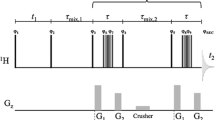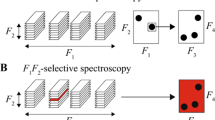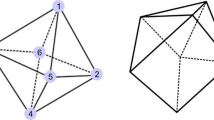Abstract
The nuclear Overhauser effect (NOE) is one of NMR spectroscopy's most important and versatile parameters. NOE is routinely utilized to determine the structures of medium-to-large size biomolecules and characterize protein–protein, protein–RNA, protein–DNA, and protein–ligand interactions in aqueous solutions. Typical [1H,1H] NOESY pulse sequences incorporate water suppression schemes to reduce the water signal that dominates 1H-detected spectra and minimize NOE intensity losses due to unwanted polarization exchange between water and labile protons. However, at high- and ultra-high magnetic fields, the excitation of the water signal during the execution of the NOESY pulse sequences may cause significant attenuation of NOE cross-peak intensities. Using an evolutionary algorithm coupled with artificial intelligence, we recently designed high-fidelity pulses [Water irrAdiation DEvoid (WADE) pulses] that elude water excitation and irradiate broader bandwidths relative to commonly used pulses. Here, we demonstrate that WADE pulses, implemented into the 2D [1H,1H] NOESY experiments, increase the intensity of the NOE cross-peaks for labile and, to a lesser extent, non-exchangeable protons. We applied the new 2D [1H,1H] WADE-NOESY pulse sequence to two well-folded, medium-size proteins, i.e., the K48C mutant of ubiquitin and the Raf kinase inhibitor protein. We observed a net increase of the NOE intensities varying from 30 to 170% compared to the commonly used NOESY experiments. The new WADE pulses can be easily engineered into 2D and 3D homo- and hetero-nuclear NOESY pulse sequences to boost their sensitivity.









Similar content being viewed by others
Data availability
The WADE pulses and the [1H,1H] WADE-NOESY pulse sequence are available at the University of Minnesota Repository Site (https://doi.org/10.13020/a37y-t692) and GitHub (https://github.com/manuvsub/WADE_NOESY).
References
Adams RW, Holroyd CM, Aguilar JA, Nilsson M, Morris GA (2013) “Perfecting” WATERGATE: clean proton NMR spectra from aqueous solution. Chem Commun (camb) 49:358–360
Ardenkjaer-Larsen JH et al (2015) Facing and overcoming sensitivity challenges in biomolecular NMR SPECTROSCOPY. Angew Chem Int Ed Engl 54:9162–9185
Carver TR, Slichter CP (1953) Polarization of nuclear spins in metals. Phys Rev 92:212–213
Chen J, Zheng G, Price WS (2017) A new phase modulated binomial-like selective-inversion sequence for solvent signal suppression in NMR. Magn Reson Chem 55:115–119
Delaglio F et al (1995) NMRPipe: a multidimensional spectral processing system based on UNIX pipes. J Biomol NMR 6:277–293
Gopinath T, Manu VS, Weber DK, Veglia G (2022) PHRONESIS: a one-shot approach for sequential assignment of protein resonances by ultrafast MAS solid-state NMR spectroscopy. ChemPhysChem 23:e202200127
Grzesiek S, Bax A (1993) The importance of not saturating H2O in protein Nmr: application to sensitivity enhancement and Noe measurements. J Am Chem Soc 115:12593–12594
Guéron M, Plateau P, Decorps M (1991) Solvent signal suppression in NMR. Prog Nucl Magn Reson Spectrosc 23:135–209
Hore PJ (1983a) A new method for water suppression in the proton NMR spectra of aqueous solutions. J Magn Reson 1969(54):539–542
Hore PJ (1983b) Solvent suppression in Fourier transform nuclear magnetic resonance. J Magn Reson 1969(55):283–300
Hoult DI (1976) Solvent peak saturation with single phase and quadrature Fourier transformation. J Magn Reson 1969(21):337–347
Hwang TL, Shaka AJ (1995) Water suppression that works. Excitation sculpting using arbitrary wave-forms and pulsed-field gradients. J Magn Reson Ser A 112:275–279
Krishnan VV, Murali N (2013) Radiation dam** in modern NMR experiments: progress and challenges. Prog Nucl Magn Reson Spectrosc 68:41–57
Kumar A, Ernst RR, Wüthrich K (1980) A two-dimensional nuclear Overhauser enhancement (2D NOE) experiment for the elucidation of complete proton-proton cross-relaxation networks in biological macromolecules. Biochem Biophys Res Commun 95:1–6
Kumar A, Wagner G, Ernst RR, Wuthrich K (1981) Buildup rates of the nuclear Overhauser effect measured by two-dimensional proton magnetic-resonance spectroscopy: implications for studies of protein conformation. J Am Chem Soc 103:3654–3658
Lee J et al (2022) Raf kinase inhibitory protein regulates the cAMP-dependent protein kinase signaling pathway through a positive feedback loop. Proc Natl Acad Sci U S A 119:e2121867119
Lippens G, Dhalluin C, Wieruszeski JM (1995) Use of a water flip-back pulse in the homonuclear NOESY experiment. J Biomol NMR 5:327–331
Liu M et al (1998) Improved WATERGATE pulse sequences for solvent suppression in NMR spectroscopy. J Magn Reson 132:125–129
Manu VS, Olivieri C, Pavuluri K, Veglia G (2022a) Design and applications of water irradiation devoid RF pulses for ultra-high field biomolecular NMR spectroscopy. Phys Chem Chem Phys.
Manu VS, Pavuluri K, Olivieri C, Veglia G (2022b) High fidelity control of spin ensemble dynamics via artificial intelligence: from quantum computing to NMR spectroscopy and imaging. PNAS Nexus (In press).
Marion D et al (1989) Overcoming the overlap problem in the assignment of 1H NMR spectra of larger proteins by use of three-dimensional heteronuclear 1H–15N Hartmann-Hahn-multiple quantum coherence and nuclear Overhauser-multiple quantum coherence spectroscopy: application to interleukin 1 beta. Biochemistry 28:6150–6156
Nguyen BD, Meng X, Donovan KJ, Shaka AJ (2007) SOGGY: solvent-optimized double gradient spectroscopy for water suppression. A comparison with some existing techniques. J Magn Reson 184:263–274
Novakovic M, Cousin SF, Jaroszewicz MJ, Rosenzweig R, Frydman L (2018) Looped-PROjected SpectroscopY (L-PROSY): a simple approach to enhance backbone/sidechain cross-peaks in (1)H NMR. J Magn Reson 294:169–180
Olivieri C et al (2018) Simultaneous detection of intra- and inter-molecular paramagnetic relaxation enhancements in protein complexes. J Biomol NMR 70:133–140
Overhauser AW (1953) Polarization of nuclei in metals. Phys Rev 92:411
Pervushin K, Riek R, Wider G, Wüthrich K (1997) Attenuated T2 relaxation by mutual cancellation of dipole–dipole coupling and chemical shift anisotropy indicates an avenue to NMR structures of very large biological macromolecules in solution. Proc Natl Acad Sci 94:12366–12371
Pervushin KV, Wider G, Riek R, Wuthrich K (1999) The 3D NOESY-[(1)H, (15)N, (1)H]-ZQ-TROSY NMR experiment with diagonal peak suppression. Proc Natl Acad Sci U S A 96:9607–9612
Piotto M, Saudek V, Sklenář V (1992) Gradient-tailored excitation for single-quantum NMR spectroscopy of aqueous solutions. J Biomol NMR 2:661–665
Price WS (1999) Water signal suppression in NMR spectroscopy. In: Webb GA (ed) Annual reports on NMR spectroscopy, vol 38. Academic Press, New York, pp 289–354
Rance M, Loria JP, Palmer AGR (1999) Sensitivity improvement of transverse relaxation-optimized spectroscopy. J Magn Reson 136:92–101
Schanda P (2009) Fast-pulsing longitudinal relaxation optimized techniques: enriching the toolbox of fast biomolecular NMR spectroscopy. Prog Nucl Magn Reson Spectrosc 55:238–265
Sklenar V, Piotto M, Leppik R, Saudek V (1993) Gradient-Tailored water suppression for 1H–15N HSQC experiments optimized to retain full sensitivity. J Magn Reson, Ser A 102:241–245
Stejskal EO, Tanner JE (1965) Spin diffusion measurements: spin echoes in the presence of a time-dependent field gradient. J Chem Phys 42:288–292
Stott K, Stonehouse J, Keeler J, Hwang T-L, Shaka AJ (1995) Excitation sculpting in high-resolution nuclear magnetic resonance spectroscopy: application to selective NOE experiments. J Am Chem Soc 117:4199–4200
Strotz D et al (2020) Protein allostery at atomic resolution. Angew Chem Int Ed Engl 59:22132–22139
Vogeli B (2014) The nuclear Overhauser effect from a quantitative perspective. Prog Nucl Magn Reson Spectrosc 78:1–46
Vögeli B, Olsson S, Güntert P, Riek R (2016) The exact NOE as an alternative in ensemble structure determination. Biophys J 110:113–126
Warren WS, Richter W (2007) Concentrated solution effects. eMagRes. https://doi.org/10.1002/9780470034590.emrstm0088.pub2
Wuthrich K (1986) NMR of proteins and nucleic acids. Wiley, New York
Zheng G, Price WS (2010) Solvent signal suppression in NMR. Prog Nucl Magn Reson Spectrosc 56:267–288
Zhu G, Kong XM, Sze KH (1999) Gradient and sensitivity enhancement of 2D TROSY with water flip-back, 3D NOESY-TROSY and TOCSY-TROSY experiments. J Biomol NMR 13:77–81
Zwahlen C et al (1998) An NMR experiment for measuring methyl−methyl NOEs in 13C-labeled proteins with high resolution. J Am Chem Soc 120:7617–7625
Acknowledgements
The authors thank Dr. M. Rosner (Ben May Department for Cancer Research, University of Chicago, Chicago, IL, USA) for providing the RKIP plasmid. All the NMR experiments were conducted at the Minnesota NMR Center (University of Minnesota, Minneapolis, MN, USA).
Funding
This work was supported by the National Institute of Health (HL 144130) to G.V. and a subcontract to GV from GM121735 (Marsha Rosner, P.I.).
Author information
Authors and Affiliations
Contributions
MVS designed the pulses, implemented the pulse sequences, and performed the NMR experiments. CO prepared the protein samples and contributed to the NMR data analysis. GV designed the research and analyzed the NMR data. MVS, CO, and GV wrote the paper.
Corresponding author
Ethics declarations
Competing interests
The authors declare no competing interests.
Conflict of interest
The authors declare no conflict of interest concerning the research presented here.
Informed consent
All the authors have seen and approved the submitted manuscript.
Additional information
Publisher's Note
Springer Nature remains neutral with regard to jurisdictional claims in published maps and institutional affiliations.
Rights and permissions
Springer Nature or its licensor (e.g. a society or other partner) holds exclusive rights to this article under a publishing agreement with the author(s) or other rightsholder(s); author self-archiving of the accepted manuscript version of this article is solely governed by the terms of such publishing agreement and applicable law.
About this article
Cite this article
Manu, V.S., Olivieri, C. & Veglia, G. Water irradiation devoid pulses enhance the sensitivity of 1H,1H nuclear Overhauser effects. J Biomol NMR 77, 1–14 (2023). https://doi.org/10.1007/s10858-022-00407-y
Received:
Accepted:
Published:
Issue Date:
DOI: https://doi.org/10.1007/s10858-022-00407-y




